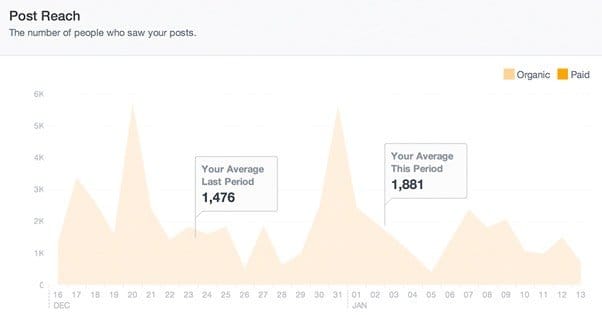 Written by ContentPowered.com
Written by ContentPowered.com
This is a surprisingly common question that comes up whenever someone looks into their Insights for their page and sees two different statistics. The problem with them is not a similar name, but a similar purpose. They both measure, in some way, the number of people who have seen a given post you’ve made as your page.
The problem that comes up is often just that these two numbers are close but not identical. When you have two numbers ostensibly measuring the same thing, with different values, you have to figure out what the difference between them is and why they read differently.
So, let’s explain what impressions are and what reach is, how they’re different, and why it’s important to have both listed.
Reach
First, let’s talk about reach. Reach is possibly one of the most commonly mentioned metrics regarding Facebook. You find mention of it everywhere, often because Facebook is doing something that decreases it for businesses.
Reach, in general, is the number of people who have seen a piece of content. If you post a picture, and 140 people see it, your reach for that picture will be 140. This is a simplification, however; there are actually three types of reach.
Organic reach is the most immediate, basic form of reach. When you post a piece of content, a certain selection of your audience is chosen by the EdgeRank algorithm to have it put in their news feed. EdgeRank, of course, determines this based on their engagement, the post type, and a host of other factors. You can read all about EdgeRank here.
Now, each time someone views your post, they have a chance to like it, share it, or comment on it. All three of these actions generate a story in Facebook. If you’ve ever seen a post in your feed that wasn’t by a friend of yours, but had “so and so commented on business X’s post” at the top, that’s a story generated by that engagement.
When you see a story secondhand like that, it’s counted as a different type of reach. Specifically, this is viral reach. Viral reach is hard to control, because it relies on your audience sharing your posts with people who may or may not be in your audience. This is why well-designed and sharable content is ideal for social media posting. Viral reach gets a lot more exposure than other types of reach.
Viral reach does benefit from having a larger base audience, simply because more people seeing your post initially means more people sharing it, and in turn more people seeing it through viral exposure.
The third type of reach, of course, is paid reach. When you run a sidebar ad that points at a post, or when you boost a post, or when you run a news feed ad, the views you get from that ad as a sponsored post are counted separately from the other two types of reach.
Paid reach has remained somewhat steady compared to the other two types of reach. Organic reach has been dropping, as mentioned above. Viral reach has also dropped, because Facebook determined that users didn’t like seeing stories in their feed when they didn’t necessarily care about the content.
When you see one figure labeled “reach” in your Insights panel, you can often hover over it to see a breakdown of which types of reach are included. In general, you can assume reach is the sum total of all three kinds of reach.
Impressions
So what about impressions, then? Well, if you’ve compared the number for reach and the number for impressions on a given post, you may have noticed something. Impressions is at minimum the same number as reach, but often it is higher.
This is because impressions is the sum total of all views to a post. You might have a reach of 140 on that picture you uploaded, but 270 impressions. 140, in this case, is the number of unique people to see the picture. Impressions is the number of times the picture was seen. You might decide that almost everyone who saw the picture saw it twice, or you might decide that 139 people saw it once and one person saw it 131 times. That would be one very dedicated person, coming back to see the picture over and over, but hey. Maybe they just really liked it.
You’ll see this more often on posts you pay to boost, particularly if your audience targeting is including or focused on followers. You’ll have some overlap with people who saw it organically, and you’ll have overlap when you reach a point you start showing the post to a person more than once. This is in reference to your ad frequency. A frequency of 1 is ideal; it means everyone in your audience saw the post once, but you aren’t over-showing it to people as a frequency any higher would imply.
So why is it so important to have both reach and impressions shown? Well, for one thing, it helps you diagnose certain issues with your posts. If you have a low reach, but a high number of impressions, it implies that your posts are being seen frequently by the same small number of people. If your impressions and your reach are the same, it implies that people aren’t seeing your posts a second time, which isn’t necessarily a problem.
With posts that go viral, you can expect a higher number of impressions than reach by a wide margin. This is because viral posts tend to be widely shared, and that means people tend to see it two, three, or more times. This also happens if an old post is given a second wave of viral activity; the new views by people who saw it the first time around are counted under impressions but not under reach.
On the other hand, reach is by far the more important metric, and that’s why more people talk about it than they talk about impressions. Reach is a more concrete indication of how much of an audience you have. It’s the difference between a view counter on your site and an analytical reading of monthly unique visitors.




I recently ran a post on my business’ page which REACHED over 3,700 people, but somehow got 0 (ZERO) impressions. Is this possible? Or some kind of glitch? If this is a true statistic, why is it true?